低成本、优化的 FPGA-HIL 实时仿真光伏电池板供电的升压转换器
IF 1.3
4区 工程技术
Q3 COMPUTER SCIENCE, INFORMATION SYSTEMS
引用次数: 0
摘要
本文介绍了由光伏电池板供电的升压转换器动态模型的开发、分析和测试。文中介绍了光伏板的数学模型,并提出了将其非线性动态特性纳入升压转换器动态模型的策略。重点放在动态行为上,对电子设备固有寄生损耗影响的建模留待今后研究。图中展示了一个离散模型,该模型可以在 FPGA 中实现实时 HIL 仿真。介绍了在查找表中实现非线性函数的优化实施策略。该策略可在不影响计算延迟的情况下优化分辨率。此外,还对模型状态计算的延迟时间进行了分析,确定每个模拟步骤的延迟时间为 100ns。这一延迟时间足以满足实时模拟的要求。最后,还展示了与软件模拟器的结果比较,以验证所提出的模型。本文章由计算机程序翻译,如有差异,请以英文原文为准。
Low Cost and Optimized FPGA-HIL Real Time Simulation of a Boost Converter Powered by a Photovoltaic Panel
This paper presents the development, analysis and testing of a dynamic model for a boost converter powered by a photovoltaic panel. The mathematical model of the panel is presented and a strategy is proposed to integrate its nonlinear dynamics into the dynamic model of the boost converter. Emphasis is placed on the dynamic behavior, leaving the modeling of the effects of parasitic losses inherent to electronic devices for a future study. A discrete model that is feasible to implement in an FPGA to achieve HIL simulation in real time is shown. An optimized strategy of implementation of nonlinear functions implemented in lookup tables is presented. That strategy allows optimizing the resolution without affecting the calculation latency. A latency analysis of the calculation of the model states is also included where a time of 100ns is established for each simulation step. This latency time is sufficient for real-time simulations. Finally, comparisons of results with a software-based simulator to validates the proposed model are shown.
求助全文
通过发布文献求助,成功后即可免费获取论文全文。
去求助
来源期刊

IEEE Latin America Transactions
COMPUTER SCIENCE, INFORMATION SYSTEMS-ENGINEERING, ELECTRICAL & ELECTRONIC
CiteScore
3.50
自引率
7.70%
发文量
192
审稿时长
3-8 weeks
期刊介绍:
IEEE Latin America Transactions (IEEE LATAM) is an interdisciplinary journal focused on the dissemination of original and quality research papers / review articles in Spanish and Portuguese of emerging topics in three main areas: Computing, Electric Energy and Electronics. Some of the sub-areas of the journal are, but not limited to: Automatic control, communications, instrumentation, artificial intelligence, power and industrial electronics, fault diagnosis and detection, transportation electrification, internet of things, electrical machines, circuits and systems, biomedicine and biomedical / haptic applications, secure communications, robotics, sensors and actuators, computer networks, smart grids, among others.
 求助内容:
求助内容: 应助结果提醒方式:
应助结果提醒方式:


